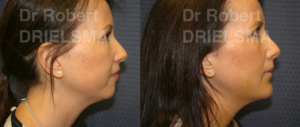Warning: Undefined array key "target" in /home/sh10236/public_html/wp-content/themes/drdrielsma/functions.php on line 72
Chin augmentation (genioplasty) involves enlarging a ‘weak’ chin in order to balance the facial profile and facial aesthetics. A ‘weak’ or under-projecting chin may give an appearance that is undesirable for many people. Due to imbalance of the upper to lower face, a ‘weak’ or under-projecting chin can give the appearance that the nose is larger than it actually is and often people seek reduction in nose size (rhinoplasty) when really the chin is a major contributing factor to their concerns.
BEFORE AND AFTER PHOTOSWhy Chin Augmentation (Genioplasty)?
‘Weak’ chins are usually due to relative underdevelopment of the lower jaw. This is often associated with mal-occlusion or non alignment of the lower and upper teeth. The lower teeth don’t come forward enough to fit with the upper teeth in the normal way. When this is corrected with jaw surgery by moving the lower jaw forward, the chin is automatically brought forward and the ‘weak’ chin is addressed. Often, however, at an early age, orthodontics (or braces) is used to tilt the bottom teeth forward and the ‘weak’ chin remains.
- The nose looks larger than it actually is
- The neck line is not defined
- There is an imbalance of the face
- Chin augmentation (genioplasty) addresses these areas
- Chin augmentation (genioplasty) is OFTEN done at the same time as rhinoplasty.
- Chin augmentation (genioplasty) can be done in two main ways, a chin implant or sliding genioplasty.
We offer digital imaging, where photos are edited to demonstrate your desired result following chin augmentation.
Chin Implant (Genioplasty)
It is suitable for achieving a more gentle or less dramatic augmentation (genioplasty). The implant is inserted onto the surface of the jaw bone lower rim either via the mouth or from an incision under the chin. The best material to use is rigid porous polyurethane (plastic) which is fixed to the bone with screws so it won’t move. The disadvantage of chin implants is that it uses plastic, not your own tissue, and so it is prone to infection and migration of the implant. It also may erode underlying bone mass.
Sliding Genioplasty
The more effective way to achieve a natural chin augmentation (genioplasty) is to move the bone of the rim of the lower jaw forward. A cut is made in the jaw bone via an incision in the lower gum. The chin point slides forward and is fixed with screws. This has the advantage not only of a more dramatic augmentation (genioplasty) but also allows lengthening in height of the chin. Because the patients own bone is used to augment rather than plastic, it is a stronger and more stable augmentation (genioplasty). It also avoids possible complications of a plastic implant.
The operation involves a general anaesthetic and a one night hospital stay. Discomfort from the procedure is usually surprisingly little. Return to work can usually be is two weeks or so.
**Results may vary for individual to individual

